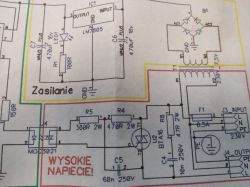yetihehe wrote: In this machine, the electrodes are from MIG.
What electrodes? As already, this contact tip is a professional name.
Alya wrote: Aa, that is, such a transformer from a welding machine will be suitable?

karol3 wrote: It all depends on which welder. While the primary winding can be used in most cases, unfortunately the secondary winding cannot.
The secondary winding can always be wound up, as long as there is room, the circus can start with columnar 3-phase cores, which are usually wound with copper flat bars of square or rectangular cross-section, insulated with dialectric material impregnation, stove, resin or mixed varnishes.
morph13 wrote: The same solution (trafo) is used in a transformer soldering iron.
I wonder if such a luck can be adapted for this purpose.
Mercy. Definitely not, because spot welding requires currents in kA. And the times of current flow are counted in ms and not rarely in us. Also, for example, the welding machine must reach the maximum current during welding in order to heat up the point-pressed sheets in a given time to the temperature of the molten plasticized metal (called the welding nucleus). The time of current flow and its value depend on the physical properties of a given material, and these in turn depend on the thickness and size of the weld that we want to obtain.








